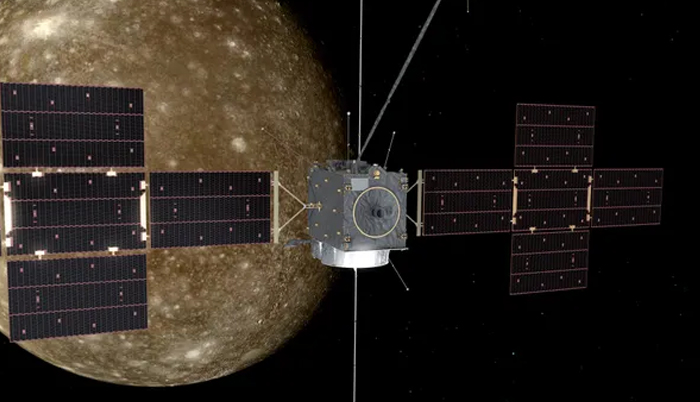![]() Home > Space & Science
Home > Space & Science
In A Virtual Reality Universe, Upcoming 'JUICE' Mission Flies By Jupiter's Moon Callisto

An artist’s impression of JUICE cruising past Callisto. (Image credit: ESA/ATG Medialab)
![]() April 15th, 2024 | 00:29 AM |
April 15th, 2024 | 00:29 AM | ![]() 1222 views
1222 views
SPACE
Still seven years from Jupiter, the JUICE mission is pretending it's already there.
Though it's still seven years from reaching Jupiter, the JUICE mission is proceeding apace — and a recent test-run simulated the mission's spacecraft flying by the Jovian icy moon, Callisto.
Having blasted off from Europe's spaceport in French Guiana a year ago, the Jupiter Icy Moons Explorer, known as JUICE for short, is still in the inner solar system, getting ready for a series of gravity assists that will throw it onto a trajectory allowing it to rendezvous with Jupiter in 2031. Its first port of call will be the giant planet's outermost Galilean moon, Callisto. This will mark the first of 35 planned flybys of the gas planet's moons Callisto, Ganymede and Europa, before the spacecraft settles into orbit around Ganymede.
At the European Space Operations Centre (ESOC) in Germany, the mission team is already preparing for this first flyby, but while using the engineering model of the spacecraft. This is an exact replica of the flight model that's currently cruising through space, with the same hardware, software and instruments. The only difference is that it is sat in a clean room in Darmstadt.
The problem that JUICE, and indeed any mission to Jupiter, faces is a time delay – how long it takes radio signals to reach the spacecraft from Earth and vice versa. This relay can take 33 minutes when Jupiter is at its closest to Earth (opposition) and 54 minutes when it is on the other side of the solar system. Thus, JUICE is programmed with software that can think and plan autonomously without waiting for commands.
One example of where JUICE's autonomy will be vital is when observing surface features on Callisto during flybys. Because we can't know JUICE's exact position when it passes through Callisto's gravitational field, however, the onboard computer must take over and fine tune the spacecraft's orientation so it can target individual surface features with its instruments to an accuracy of a fraction of a degree.
"We need JUICE to be able to react with its own 'eyes' and its own 'brain,'" said Ignacio Tanco, who is JUICE's Flight Operations Director, in a European Space Agency press statement. "When Callisto appears in the field of view of its navigation camera, it needs to be able to identify important features on the moon's surface, rotate itself to point its instruments at them, and then continue rotating to keep them in view as it flies past."
The team at ESOC had to make the engineering model believe it was really in space and flying past Callisto by projecting computer-generated images of Callisto into the model's navigation camera. The images mimicked the orientation and phase that Callisto will have when JUICE does the flyby for real in 2031.
Giulio Pinzan, who is the Spacecraft Operations Engineer at the European Space Agency, likened it to strapping the engineering model to an immersive virtual-reality headset and letting it move around that virtual space.
"The navigation software had to react to these images," said Pinzan. "If it noticed that it was approaching Callisto at the wrong angle or facing slightly the wrong direction, it had to attempt to correct these errors without our help."
Three days were set aside for testing at ESOC, and it was not expected to be plain sailing — the entire point of these practice runs is to smooth out the kinks. Because of the complexity of the task, it wasn't feasible to test on a software simulator first, where most of the gremlins could be ironed out. Instead, the JUICE team expected to have to endure a lot of trial and error, as well as rewriting of software, to get it to work.
Yet, the engineering model succeeded on day one, successfully targeting the images of Callisto and keeping locked onto locations on the moon's icy surface as it performed a virtual flyby, rolling to keep the moon in view.
"We really have to praise our Flight Dynamics team," said Giulio. "Their mathematical calculations were spot on and enabled us to cruise through a clean flyby on the very first attempts despite the lack of experience they would usually gain from experimenting with the software simulator. It was amazing, really. They surprised even us."
The next step for the JUICE mission in the real world is a Lunar-Earth Gravity Assist, or LEGA for short, in August. First, JUICE will fly past our moon and steal some of its orbital momentum, followed less than 24 hours later by zipping past Earth and getting an additional gravity assist to increase its velocity. It's the first time this kind of double gravity assist has ever been attempted, but because JUICE is one of the most massive interplanetary spacecraft ever launched, it needs more help to get moving between planets. In 2025, JUICE will get an additional gravity assist from Venus, and then two more flybys of just the Earth in 2026 and 2029 will give the spacecraft sufficient velocity to climb out of the sun's gravity well and head towards Jupiter at last.
Source:
courtesy of ENGADGET
by Keith Cooper
If you have any stories or news that you would like to share with the global online community, please feel free to share it with us by contacting us directly at [email protected]